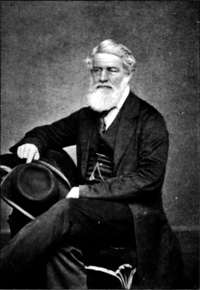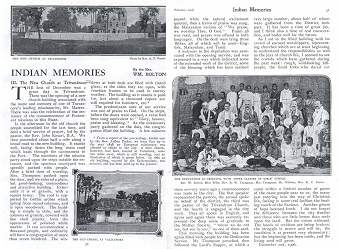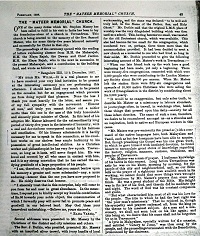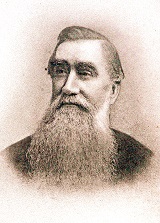THE BEGINNINGS |
|
From the beginning of the Protestant missionary enterprise in Travancore, the LMS missionaries nursed the unfulfilled desire to establish a mission station and to found a church in Trivandrum, the capital of this kingdom.When the first missionary, William Tobias Ringeltaube, met a few believers - Vedamanikkam and others - in 1806 at Mayiladi, a remote village in the Travancore border, he had to strive hard to secure permission to build a church there. It was the Dewan who had to grant permission. Permission was finally obtained in 1809, after Ringeltaube made many visits to Cochin and Quilon (where the Residency was situated at that time) to meet the Resident, Col. Macaulay, with the request to intervene with the Dewan on his behalf. Even then, the permission came in the context of the British troops crushing the revolt led by Velu Thampi Dalawa and establishing British suzerainty over Travancore. In the course of Ringeltaube’s journeys to visit the Resident, he baptised several people (e.g: Gunamudayan in Nellikkakuzhy) and founded churches (e.g: Valiathura). Till he secured permission to build at Mayiladi, Ringeltaube stayed at Tirunelveli, outside the borders of Travancore, and journeyed from there by horse and on foot to do mission work in Travancore. It is significant that C. Silvester Horne, author of The Story of the LMS (1902) states: “Finding that, at that time, no settlement could be made in Trevandrum, the capital of Travancore, Ringeltaube betook himself to [= he went to] the province of Tinnevelly” (P.96) i.e., he wished to make Trivandrum his base but could not.
Rev. Charles Mead, who took charge of the Travancore Mission after Ringeltaube (in 1818) again tried and failed to depute a missionary to Trivandrum. It was in the context of his failed attempt in 1819 that the first Malayalam Mission of the LMS was started in Quilon in 1821. In 1827 he made an attempt to send William Miller as missionary but could not secure permission. In 1828 William B. Addis was posted to Valiathura, the fishing village where there was a small LMS church; but the Dewan would not allow a missionary to be stationed even outside the city. It was the existing social conditions which caused such severe opposition to the presence or work of a missionary in Trivandrum. A native State that was dedicated to the local deity Padmanabha by the kings, a city which was built around that temple, a concentration of power in the hands of the Brahmins connected with the temple and occupying public positions, the insistence that the temple and the roads in the city should not be polluted by the approach of the low caste or of foreigners – all these conspired to prevent the Travancore Mission of the LMS, which began in 1806, from entering Trivandrum even after 30 years.
In the meantime, Swathi Thirunal, the then Maharaja of Travancore, visited the LMS seminary established by Mead at Nagarcoil, the first English School in Travancore. The seminary established by Ringeltaube and Mead was a school where English education of secondary school standard was imparted even as the Bible and Christian doctrine were taught, not like the more specialised theological seminaries of later times. The Raja, who was impressed with the school invited the headmaster, John Roberts, an educational worker of the LMS, to start a school in Trivandrum. Since Roberts insisted that he would go only if permission was granted to teach the Bible, the Raja consented. In 1834, Roberts started the Free School where the Ayurveda College is situated today, and in 1835, it was taken over by the Raja. The Raja’s Free School developed later into the Maharaja’s College (today’s University College) and the headmaster, John Roberts was provided the bungalow of one Kuttiyappa Mudaliyar in the city, to stay at Sirkar expense. It may be because Roberts was seen as an educationist that he could stay in Trivandrum while missionaries were forbidden.
THE FIRST MISSIONARY

Charles Mead, who went on furlough to England in 1838, returned with a team of missionaries, landing at Quilon on March 31st of the same year. Among them was Rev. John Cox, who was deputed as missionary at Trivandrum, if permission could be secured. Wasting no time, Cox and Mead met the Resident, Col.Fraser in Trivandrum on April 3rd on the matter of getting the Dewan to grant permission. The Dewan, who happened to be there, when summoned by the Resident informed that there would be no objection except for the Fort where the Raja lives and where the temple is situated, any road frequented by the Raja, and the vicinity of any temple. The Resident advised them to find a place which could not be objected to and apply in writing for it. The Dewan suggested Pettah, populated by low castes and Anglo- Indians, which was outside the city limits. Cox spend the next two days going around Trivandrum with Mead, trying to find a suitable site for the mission. On April 10th he brought Mrs. Cox from Quilon and they were accomodated at the house of John Roberts. Finally, they located a suitable spot - a hill on the outskirts of the city, unpopulated, where school rooms, a chapel (in those days non-Anglican churches were called chapels), a mission bungalow and houses to settle Christians could be built. It was the influence and firm intervention of Col.Fraser, a believer, which finally realised the dream of the LMS missionaries since the early 19th century. The letter granting the supposedly devil-haunted, unpopulated wooded hill, free of cost was written to Fraser. Rebecca Parker writes: “No one was found brave enough to clear the hill top of trees and jungle until Mr. Cox, axe in hand started work; and when nothing happened to him, workmen came along and in due course a rambling bungalow appeared on the top of the hill. Later, a church was built half -way down and a school at the foot....” (Father of 25,000 - p.64). Cox, who had received not only hospitality but also valuable advice and information from John Roberts, obtained a rented house within travelling distance of the mission spot, while the construction was going on (Cox writes that no house was available in Trivandrum, and this house was small and badly situated). Cox and his wife shifted to this house at Pettah on May 3rd. At this house, Cox conducted the first Protestant worship service in Trivandrum for native Christians on 1838, May 13 (Sunday). He wrote: “May 13. Began service in Tamil at our house where we continue every Lord’s day afternoon at five, the Readers interpreting for me.” From the available records, this Tamil service marks the beginning of the Trivandrum Church. There were Tamil Christians who were employed in the Government press, the Free School and in the houses of many British officers. The first Readers (i.e. Catechists) who assisted Cox were four men from the Neyyoor mission centre.
THE CANTONMENT CHURCH

Even though this was the first organised worship service for native Christians, Cox writes that the English service for British officers in the Cantonment and the Residency was being held at the house of John Roberts, and that Col. Fraser himself would read out the written prayers and sermon (which indicates that there was no Anglican chaplain). There was no Christian church in Trivandrum at the time of Cox’s arrival in 1838. But the British officers had collected money by subscription among themselves and were building a church in the Cantonment, near the present University Library. Col. Fraser was the prime mover of this project also. In his Memoir of Travancore, perhaps the first attempt at a written history of Travancore (probably written in 1838 itself, it was printed from the Govt. Press in 1839), Capt. Horsley, the Engineer of the Travancore sirkar (equivalent to today's Chief Engineer), writes: The Barracks for the 2 battalions of Nair Sepoys, in the service of this Government, are situated, half-way between the Fort and Cantonment, at which latter the Officers and other European gentlemen reside. A Protestant Church has lately been erected in the Cantonment by subscription among that class of the European community, at which Divine Service will in future be performed by a Minister connected with the London Missionary Society. Even on Cox’s first visit to him on April 3rd, Fraser had prompted him to take up this English service. At the Resident’s insistence, Cox conducted the English service for the first time on April 22nd, Sunday. Since Fraser was transferred as Resident at Hyderabad, the British officers wanted to open the church before his leaving and thus, the still unfinished church was opened for worship on Sunday, August 5th, 1838. Cox preached on Psalm 122:1. Fraser donated silver communion vessels stamped with his insignia to the church, which are still our treasured possession.
Throughout India, garrison churches were built under the Anglican establishment and Anglican chaplains appointed at places where the British cantonments were situated. However, since the Cantonment and the Residency were both at Quilon till the 1820s, the Anglican garrison church was also situated there (St. Thomas Church). There was no Anglican ecclesiastical presence at all in Trivandrum. The LMS was a mission society supported by the men and money of the Congregational church and Rev. John Cox was born, brought up and ordained a Congregationalist. The British decided not to make the Cantonment church a mere Anglican church but, as Cox writes.
“The church is to be left open for the use of all, by not being consecrated.” Cox writes elsewhere why they did not want it consecrated by the Anglican bishop: “The intention of the subscribers was to have the place preserved for all to the exclusion of none and we fear an attempt to consecrate and thus appropriate it to the Establishment - which would prevent all service whatever for the greater part of the year” (Letter dt. Sept 11th, 1840). At that time (1837 onwards), the chaplain from Quilon was authorised to visit once a month to meet the needs of the Anglicans here, but, Cox says “...there is no probability of a chaplain being appointed” specifically for Trivandrum. To secure the use of the church for all Protestant Evangelical Christians, John Roberts, Rev. John Cox and the commander of the British Brigade Maj. Campbell were constituted to prepare a Trust Deed. There was no document proving ownership of the land, which was an impediment (we can only speculate that either the sanction of land was made directly to Fraser, or the permission was to construct it on government land) but the Trust Deed was registered in 1842.The first trustees of the Cantonment Church, as cited by the church historian C.[Charles] M.[Masillamany] Agur, who was a descendant of Vedamanikkam, included Col. Fraser (the Resident), John Caldecott (Astronomer), Capt. William Henry Horsley (Engineer), John Roberts, James Eaton (Surgeon), Capt. William Daly (Commandant of the Nair Brigade) and other British officers in Trivandrum.
THE TRIVANDRUM CHURCH
Quite naturally, the native worship that began at Pettah was shifted to the Cantonment church where Cox was conducting the English service. Our Tamil and Malayalam services were held following the English service for the British. Since this church could not be appropriated for Anglicans, a new English Church was built in 1859 for them (named the Christ Church) and a chaplain for Trivandrum, residing here, was appointed from 1860. H.T. Wills, in his write-up about the old church at Cantonment states that, since 1859, “...the old church was thus left practically to the sole use of the L.M. Society”. The LMS had local churches (parishes) established by missionary work in various localities, such as the Thirupuram church, the Valiathura church, the Nellikakuzhy church. The Trivandrum Church is, similarly, the church founded by John Cox at Pettah for Trivandrum. The worship could have been held at the LMS mission school at Pettah founded by Cox, till the shift to the Cantonment Church, probably after the Trust Deed in 1842. Another church built by Cox was the Highfield Chapel at the mission compound in Kannamoola (which later housed the LMS seminary and now the Kerala United Theological Seminary). The Kannamoola chapel was situated half way up the hill, by the side of the graves of Mrs. Cox and one of their daughters, which still exist in the seminary campus. It has no relation whatever with today’s Kannammoola Church, which was started in 1930 as our branch church at the request of the seminary principal, Rev.Eastaff. Just as there was one parish church for each place such as Amaravila or Kodiyannoorkonam, the Trivandrum church was the parish church for Trivandrum city. This is why the whole city is still our parish area.
Rev. T. W. Bach took charge as the third LMS missionary at Trivandrum in 1894. By this time the need was keenly felt for a new and bigger church building to accommodate the Trivandrum Church. Due to the growth of the church, the Cantonment Church became inadequate since it could seat only about 300 while the average attendance was about 600. Moreover, the building itself started collapsing despite maintenance. Hacker, Wills and Bach initiated a church building project in memory of Samuel Mateer. The article by Mr. H. T. Wills in the LMS publication, The Evangelical Magazine and Missionary Chronicle, September 1896 (pp 207, 208), gives a clear description of the Cantonment church and the need for a new building. The foundation stone was laid in 1897, during the tenure of Rev. Bach. A report appeared in the February 1898 issue of the Chronicle about the stone laying. After missionary activity became accepted in Trivandrum, the desire grew to have the mission centre at a more central location. Cox’s successor, Rev. Samuel Mateer took the initiative in buying today’s LMS compound in 1866. But even in his tenure we still worshipped at the Cantonment Church.. After Mateer left in 1891, the church was in the temporary charge of Rev. I. H. Hacker (the Neyyoor missionary; since Trivandrum mission station came under the Neyyoor district of the LMS) along with Mr. H. T. Wills (city missionary). Samuel Mateer died in 1893.


In 1900, the Rev. Arthur Parker took charge as missionary (the fourth LMS missionary in Trivandrum). The actual construction of the new church building was undertaken in four years (1902-1906). It was dedicated on December 1, 1906 by Rev. R. W. Thompson, the Foreign Secretary of the LMS who was heading a deputation visiting the mission field as part of the centenary of the South Travancore Mission of the LMS (started in 1806 by Rev. Ringeltaube at Mylaudy). For more details see the written account on the dedication by a member of the LMS deputation, published in the February 1907 issue of the Chronicle. The congregation met for the last time at the Cantonment chapel on 1 December 1906 and went in a procession to the new Church at the LMS Compound. No new congregation was founded. The Indian pastor (Rev. John M. Kesari – he was the successor of the first Indian pastor Mathew Kesari, who was appointed in 1895), the Church committee (this was the third committee; a committee consisting of Indian deacons was first appointed in this church in 1900), the congregation, all remained the same. Because of this, the shift of location was scarcely even mentioned in the Church committee minutes. The old chapel continued to exist till the second decade of the 20th century when it was dismantled by the decision of the Church committee.

Thus, 13 years after Mateer’s death, the new church building constructed in the LMS compound for the Trivandrum Church was dedicated in 1906 as the Mateer Memorial Church. Even after this, in our Annual Reports, below the photo of Rev. Mateer it is still printed: “In whose memory the Trivandrum Church is built” - i.e. we, the Trivandrum Church remind ourselves that our present church building was built in Mateer's memory. It has to be remembered that the name of the Church (sabha) was Trivandrum Church, and Mateer Memorial Church is the name of the church (palli). The Church is a community of believers, a worshipping community; the church building is subordinate to it, and may be constructed many years after the Church was founded, or perhaps demolished and reconstructed, or even shifted to a different location, as we did. The Church begins at a place when baptised believers gather together and worship for the first time under a pastor. Thus the Trivandrum Church was founded on 1838 May 13 at Pettah. This Church that began at Pettah was shifted to the Cantonment Church in the 1840s - shared with the British till 1859 and thereafter used exclusively by us till 1906. In the year 2006, we celebrated the centenary of our present church building, the Mateer Memorial Church, where we have been gathering since 1906. We commemorated the 175th year of the founding of our Church in 2013.